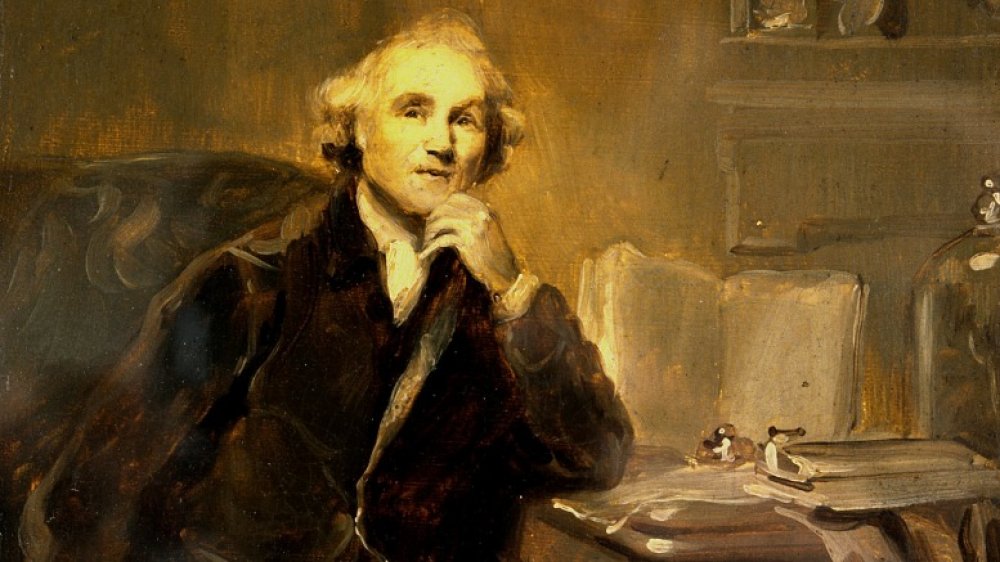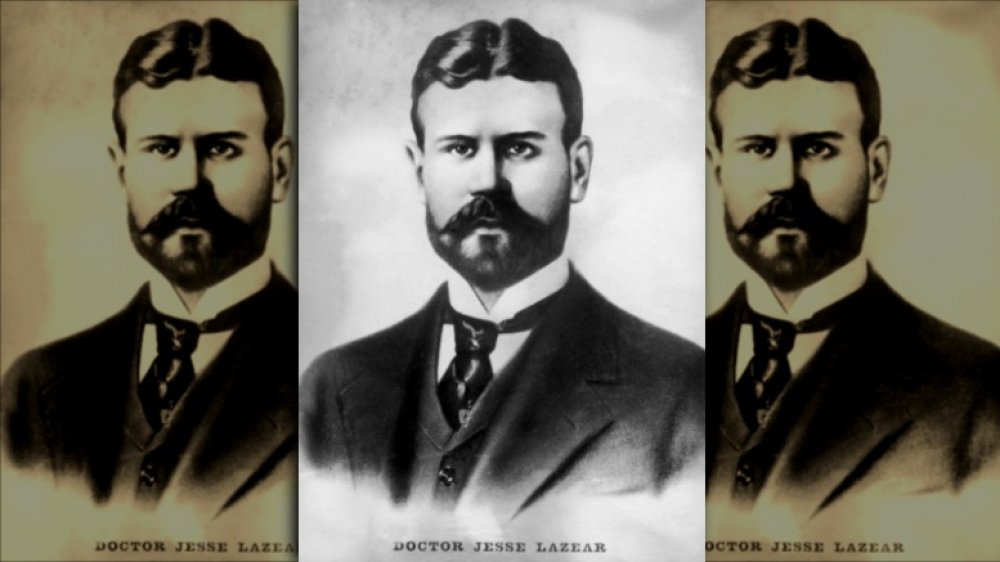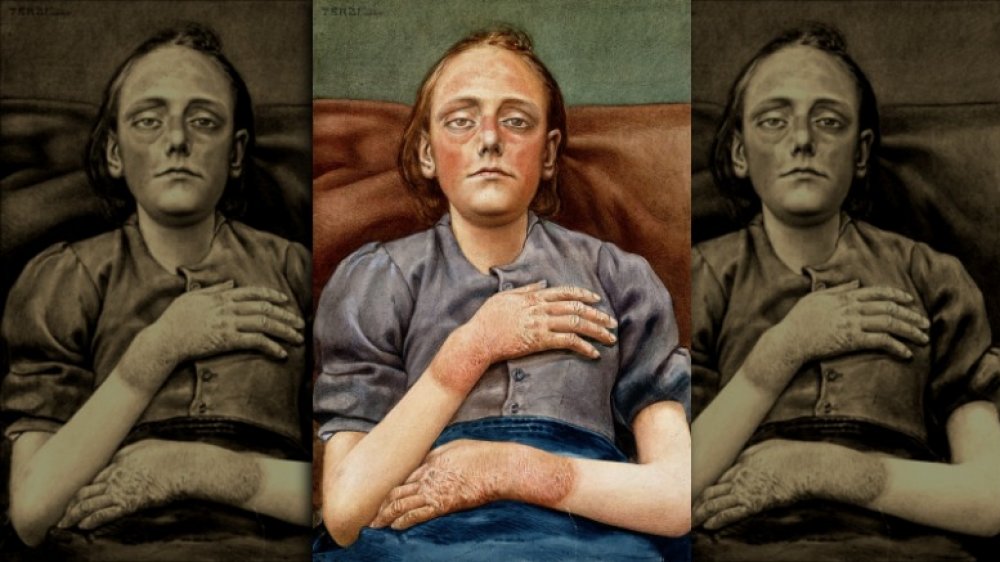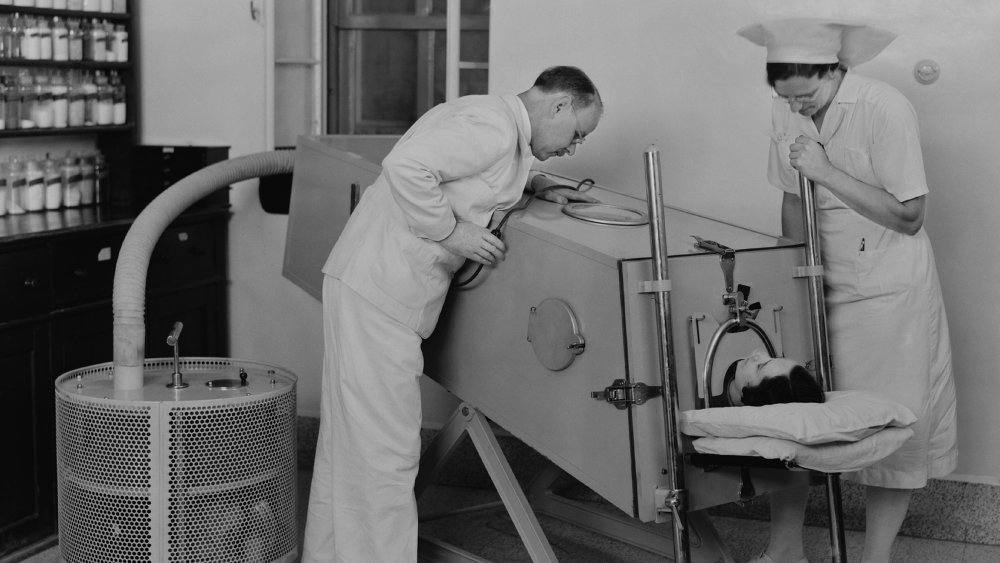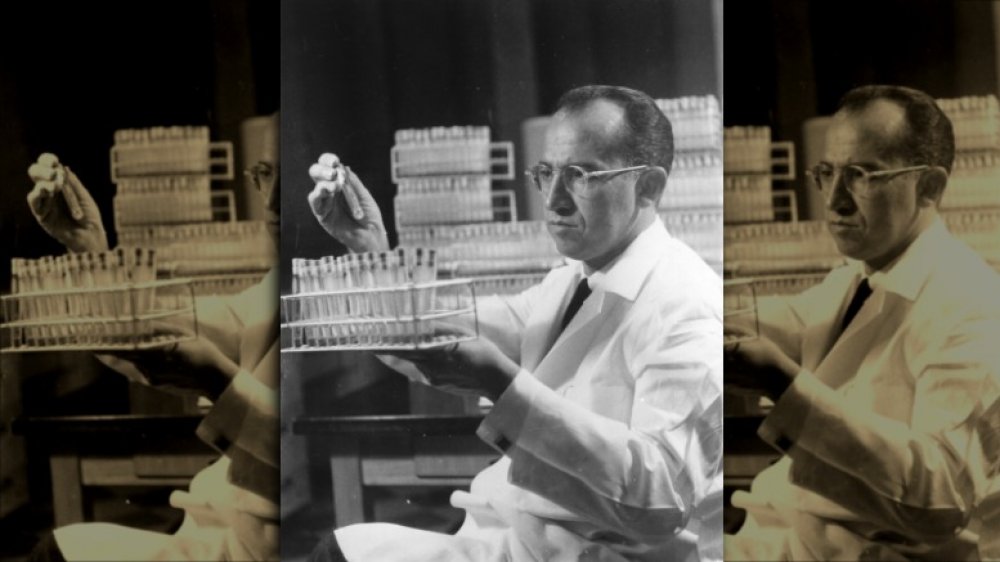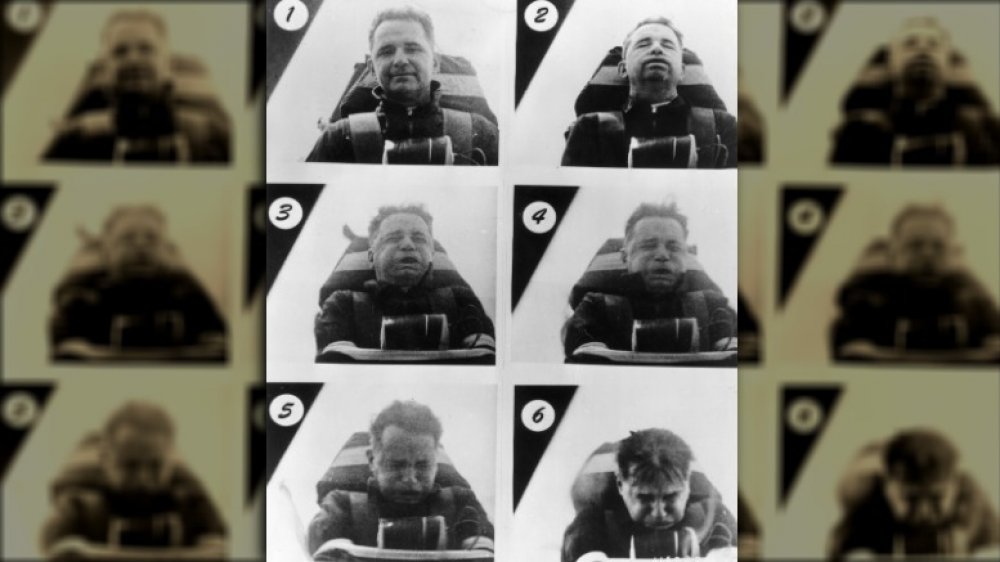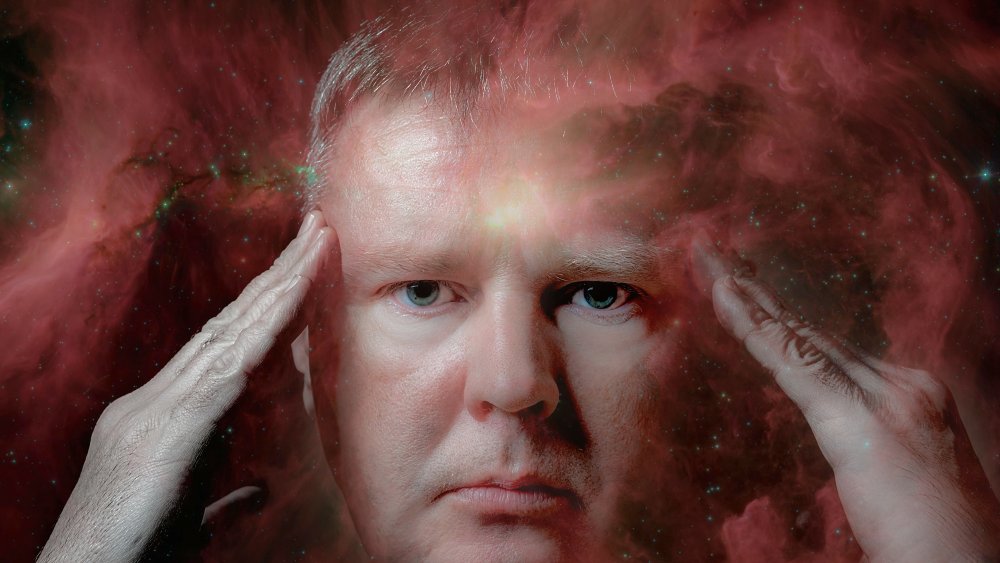Doctors Who Experimented On Themselves
We all know the stories about doctors experimenting on unsuspecting patients — it's the kind of real-life horror that inspires horror movies for decades. From Nazi twin experiments to Japan's World War II biological warfare project to the US Tuskegee syphilis experiment, medical ethics — and the well-being of unwilling human test subjects — hasn't always been at the forefront of researchers' minds.
But not all ethically questionable experimentation is done on innocent victims. In some cases, doctors themselves take risks to prove crazy theories and push the boundaries of what's possible. Over the centuries, some scientists have really gone the extra mile to prove their theories. Shockingly, as Dr. Allen B. Weisse notes in the Texas Heart Institute Journal, relatively few doctors have died as a result of their self-experimentation, at least in the 20th and 21st centuries. And a number have won Nobel prizes for their contributions to biological science and medicine.
Still, what these folks did to themselves in the pursuit of knowledge seems crazy...
John Hunter, intrepid — or insane — STD researcher
Scottish physician John Hunter dropped out of school at 13, possibly due to a learning disability, as The James Lind Library relates. But he didn't let that stop him from becoming one of the most acclaimed surgeons of 1700s London. After an early career as a grave robber, procuring dissection specimens for his brother's medical school, Hunter would serve as an anatomy lecturer, military doctor, and dentist. He pioneered dental implant surgery — paying poor folks for their teeth and transplanting them into the toothless gums of the gentry.
But Hunter is best known for a questionable experiment he reportedly performed on himself. STDs were rife in 1760s London, and Hunter made bank treating the rich and famous. He developed a theory that gonorrhea was actually an early stage of syphilis and then set out to prove it. Intentionally infecting yourself with an STD is not a great idea. Doing it with a sample from a patient who has two diseases is even worse, as Dr. John Herman relates. As it turns out, the gonorrhea sufferer from whom Hunter obtained his sample also had syphilis, which only led Hunter to conclude that he was right.
But Hunter didn't stop there. Now equipped with a couple of STDs, he decided to treat his self-imposed woes. That involved rubbing toxic mercury on himself and cutting off any sores, as Healthline notes. Worst of all, Hunter wasn't even right — the two conditions are caused by separate infections.
Stubbins Ffirth swallowed vomit for science
Yellow fever was a devastating, horrifying illness that led to people vomiting black bile and dropping dead in the streets. But until the early 1900s, no one knew how it was transmitted, sometimes leading to people abandoning their families and fleeing to save themselves from the plague among them.
That changed with the help of some horrifying self-experimentation by Stubbins Ffirth, who was sure that yellow fever couldn't be spread person-to-person. While studying medicine at the University of Pennsylvania in 1804, Ffirth wrote a thesis called A Treatise on Malignant Fever; with an Attempt to Prove Its Non-Contagious Nature, according to his JAMA biography. The thesis started out normally enough — he detailed previous experiments into the nature of yellow fever transmission, including animal experiments that had been conducted a few years before.
But animal experiments aren't necessarily replicable in humans. And no sane human would consent to "injection, ingestion, inhalation, or subcutaneous instillation of excreta from the afflicted," as Ffirth put it ... right?
Wrong. Unable to get volunteers, Stubbins took matters into his own hands, rubbing vomit from infected people into cuts on his arms, dropping infected bile into his eyes, and eventually swigging fresh black vomit straight from a patient ... and completely failing to drop dead, as New Scientist points out. As it turns out, yellow fever is transmitted via mosquitoes, and it's virtually impossible to get infected by person-to-person contact. But what a way to find out.
Jesse Lazear sacrificed himself to cure yellow fever
Despite Stubbins Ffirth's pioneering work on yellow fever transmission in the early 1800s, we still didn't know how to cure the disease for another century. And that took the work of another daring, completely bonkers researcher: Jesse Lazear.
A team of doctors led by Dr. Walter Reed (for whom the US military medical center is named) was dispatched to Cuba in 1900 in the aftermath of the Spanish-American War with the mission of fighting this deadly plague, as the AMA Journal of Ethics recounts. But their work on determining whether the disease really was transmitted by infected mosquitoes hit a wall when the ethics of injecting yellow fever samples into healthy soldiers was questioned.
Reed had already returned to Washington, leaving the experiments up to a couple young researchers in Cuba. One, Jesse Lazear, decided to go rogue — he was absolutely convinced that mosquitoes transmitted the disease and was frustrated at the lack of progress. So, as History of Vaccines recounts, he took some mosquitoes he'd bred for the purpose, got them to bite infected patients, and then let them bite him. Lazear came down with yellow fever, as did two other "intrepid" volunteers.
The other guys recovered. Lazear, as PBS notes, did not, dying of yellow fever on September 25, 1900. In his eulogy, Dr. Walter Reed noted that "his death was not in vain. His name will live in the history of those who have benefited humanity."
Joseph Goldberger's infamous filth parties
Why merely inject yourself with a deadly disease when you can instead prove its origin by taking pills filled with the pus, poop, and urine of patients?
That's precisely what epidemiologist Dr. Joseph Goldberger did starting in 1916, according to the Science History Institute. Goldberger, a US government researcher, was trying to prove that pellagra, a mysterious disease plaguing the South, was caused by malnutrition rather than germs, as the National Institutes of Health relates. No one wanted to believe that this horrible malady, marked by diarrhea, rashes, dementia, and eventually death, was completely preventable by providing a little fresh food — better to think that the poor were nasty, dirty things who brought suffering on themselves.
After determining that he could cure pellagra simply by feeding sufferers a decently balanced diet, as Hektoen International relates, Goldberger fought back against his critics, who insisted that the disease was spread by an unidentified germ. He scraped the scabs of infected patients and mixed that with stool samples and cracker crumbs. He served the resulting delicacy at "filth parties" where he, his wife, and their dinner guests would chow down on the pellagra-laced bread balls. A few people had tummy trouble, but no one caught full-blown pellagra — proof, as Discover notes, that pellagra wasn't transmitted by germs.
Eventually, through more typical lab work, Goldberger proved that a deficiency in niacin (vitamin B3) caused pellagra, ending untold suffering by encouraging simple dietary tweaks.
Werner Forssmann catheterized his own heart
Heart attacks afflict millions every year, but no one really knew how to deal with them before the 20th century. In 1896, one prominent doctor even declared that any heart wound was completely untreatable. Clearly, no one ever told German doctor Werner Forssmann this. As an article in Heart points out, he was convinced that you could thread a small tube into a vein, navigate to the heart, and use that tube to either clear blockages or deliver medicine straight to the heart itself.
Everybody thought he was crazy.
In 1929, at the tender age of 25 and just barely out of med school, Forssman was sure he knew better. He sweet-talked the supply nurse at his hospital into giving him access to a long enough catheter to do a human trial. He then somehow persuaded her to be his test subject — or so she thought. After Forssmann strapped her to a table to prevent her from interfering, according to The Hospitalist, he got down to business.
Forssmann inserted a catheter into his arm and ran it into his own heart using a mirror to guide him. He then headed over to the X-ray department to see how he'd done, according to Classics in Thoracic Surgery. Always looking to push the boundaries of both diagnosis and treatment, Forssmann would go on to catheterize himself six more times. In 1956, he won the Nobel Prize for his work.
Maurice Brodie injected himself with an unproven polio vaccine
Polio, a deadly disease that can leave one of every 200 victims with paralysis, was a constant worry until the mid-20th century.
In the 1930s, as an article in Medical History notes, animal test subjects, and particularly monkeys, were darned expensive. In contrast, human medical experimentation was cheap — and it wasn't regulated. You could pretty much just do what you wanted if you could round up some unsuspecting patients. And with the noble goal of developing a vaccine to eliminate polio, in 1935, Dr. Maurice Brodie and several colleagues decided to split the difference between expensive animal tests and quasi-ethical human studies by experimenting on themselves.
After developing a vaccine using high concentrations of formaldehyde to inactivate the polio virus, Brodie and his buddies injected themselves with the barely tested shot, and Brodie went on to test the vaccine in a small group of children and then a larger one. Unfortunately, as a paper from Rowan University's Cooper Medical School notes, in an effort to lessen the gruesome side effects of injecting formaldehyde into people's veins, Brodie inadvertently reduced the preservative to below the point needed to inactivate the virus. A number of his test subjects developed polio.
Jonas Salk tested his polio vaccine on himself and his kids
Unfortunately, Maurice Brodie's 1930s polio vaccine was finicky — either you used too much formaldehyde and killed the patient, or you used too little and they got polio and died. With researchers a little gun-shy after this and other prominent failures, the first truly effective polio vaccine didn't come along until the 1950s, when researcher Jonas Salk tested his version on himself ... and his kids.
As The New Atlantis notes, in the '50s, the fear of polio was second only to the fear of nuclear annihilation in the minds of the American people. Every summer, thousands contracted the virus, and many were paralyzed or killed. Salk, working at Pittsburgh, Pennsylvania's, Municipal Hospital, dealt with many tragic cases and was determined to prevent more parents from losing their kids. So he risked his own life, and those of his children, to save others. In 1952, according to The Scientist, Salk tested his experimental vaccine on himself and his family before applying for broader testing permission. He sterilized the needles on the stovetop, as History.com notes, and then the Salk family took the plunge ... and didn't get polio.
Eventually, after an epic PR campaign, infighting among rival scientists, and a heck of a field test, the Salk vaccine was introduced to the public in 1955. Today, thanks to the Salk vaccine, the Sabin vaccine, and a few others, polio has been all but eliminated globally
John Paul Stapp broke his bones to keep you safe
Not all self-experimentation involves injecting yourself with icky stuff. Sometimes, it means strapping yourself into a terrifying rocket sled to see if it'll kill you.
Turns out, as Air Force surgeon Dr. John Paul Stapp discovered, you can survive a lot. During his experiments, Stapp gave himself dozens of broken bones and a retinal hemorrhage at accelerations of up to 45 g, paving the way for breaking the speed of sound and putting humans in space, as his New York Times obituary noted when he passed away at age 89.
The "fastest man on earth," Stapp was determined to keep his flyboys safe during flight maneuvers. So in the early 1950s, as the National Aviation Hall of Fame notes, he built a rocket sled called the Gee Whiz. Stapp acted as his own guinea pig, taking 40-g joyrides beginning in 1952. As Popular Science recounts, he went on to build another rocket sled, the Sonic Wind, in which he would accelerate to 632 mph in under six seconds and then slam to a stop in just 1.4 seconds — the deceleration equivalent of hitting a brick wall at 120 mph.
As the Smithsonian National Air and Space Museum points out, Stapp's research led to the development of safety harnesses, ejector seats, and even automobile safety equipment that keeps us all safe and sound on the roads today, at speeds much less than he experienced.
Albert Hofmann went on a life-changing trip
In 1938, a pharmaceutical researcher at Swiss firm Sandoz, Albert Hofmann, was tinkering with various organic molecules out of a vague sense of boredom, as The Atlantic reports. None of them did much of anything, let alone boost circulation and respiration, as Hofmann had hoped. After noting that a few animal subjects were "highly excited" when they got the 25th version of his lysergic acid compound, he set the research aside.
But something gnawed at Hofmann. He couldn't stop thinking about that last compound — for five years, in fact. In 1943, he went back to the bench and synthesized the compound again, and then he started feeling kind of funky. He concluded that he must have somehow exposed himself to the new substance. A few days later, on April 19, 1943, Hofmann called his assistant to watch, just in case, and then dosed himself with 250 micrograms of his compound: LSD-25. He promptly proceeded on a hallucinogenic trip, including a psychedelic bike ride home, as Rolling Stone recounts.
Hofmann went on to become a leading researcher in psychedelics, investigating the use of LSD in psychiatric treatment and synthesizing psilocybin, the hallucinogenic compound in magic mushrooms, according to Encyclopedia Britannica. And yes, he continued tripping regularly as part of his research.
Barry Marshall gave himself ulcers and then cured them
As recently as the early 1980s, researchers were still arguing about what caused ulcers. Treatment was largely limited to minimizing patient pain, as the LA Times notes. That changed with the pioneering and slightly insane work of Australia's Dr. Barry Marshall. Marshall was convinced that ulcers were caused by bacteria. But the medical establishment firmly believed that no bacteria could survive the acidic environment of your average stomach.
In 1981, Marshall had teamed up with a pathologist, Robin Warren, who had found H. pylori in the guts of severe ulcer sufferers. After examining biopsies, the two were convinced they could treat ulcers with a round of antibiotics, as Discover relates. But they couldn't prove their theory with lab rats and couldn't get anyone to agree to human studies, since the powers that be were sure they were nuts.
As New Scientist recounts, in 1984, a frustrated Marshall turned to the one human subject he could ethically enroll in an experiment: himself. He mixed up a cocktail of H. pylori, swallowed it, and gave himself a raging case of ulcers. Two weeks later, he took antibiotics at his wife's urging, and boom: No more ulcers. In 2005, having given the middle finger to the medical establishment with their pioneering work, Marshall and Warren won the Nobel prize.
Interestingly, Marshall stated in a 2008 interview that he was inspired to experiment on himself partly by John Hunter (of syphilis fame).
Jack Barnes got himself stung by a deadly jellyfish to save lives
In the mid-20th century, a mysterious illness was claiming the lives of swimmers in Australia. One minute, they'd be walking around, the picture of health. The next, they'd drop dead of cardiac shock, as Life in the Fast Lane relates. Those patients were the lucky ones — others were in so much pain, combined with a sense of apocalyptic anxiety, that they begged their doctors to kill them, as Discover notes.
And then Jack Barnes got involved. As Toxicon points out, the former commando-turned-GP knew no fear. Long fascinated by venomous marine animals, Barnes concluded that the mystery illness was caused by an unknown venomous species. Years of searching eventually yielded a teeny possible culprit, the four-tentacled box jellyfish ... which Barnes promptly tested by getting it to sting him, his nine-year-old son, and a local lifeguard who'd come along for a night of jellyfish hunting. Within 20 minutes, all three were rushed with the hospital in gut-wrenching pain. Barnes' own account of the symptoms is pretty intense.
According to LITFL, the illness was named Irukandji syndrome after an Aboriginal tribe in the region where the affliction was originally found. Today, box jellies are stinging people from the Great Barrier Reef to Hawai'i as they expand into new territory thanks to global warming. There is no cure, though prompt treatment with opioid painkillers can usually prevent death.
Self-experimentation continues today
Today, medical ethics boards and university research departments have a tight control on human experiments, but rogue scientists will always use the handiest test subject: themselves. As one 2012 paper points out, medical self-experimentation killed surprisingly few researchers in the 20th century, making it an oddly attractive proposition for researchers on the frontiers of science.
But doctors aren't the only ones performing self-experimentation. From basic biohackers who track their every bowel movement to folks who implant chips under their skin, there are plenty of people experimenting on themselves. We'll likely see a resurgence of self-experimentation with vaccines in light of the COVID crisis, as well, as The Scientist reports. The MIT Technology Review has interviewed a group of "DIY scientists" testing potential COVID-19 vaccines on themselves, frustrated with the pace of research.
Is it safe? Maybe. Is it sane? Maybe. Does history support potentially deadly self-experimentation? Kind of. It seems that sometimes, to push the limits of science, you have to take matters into your own hands.

